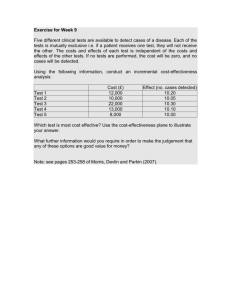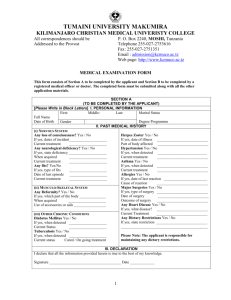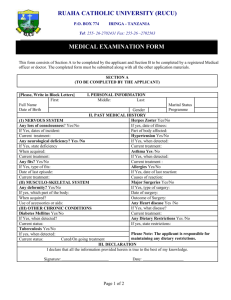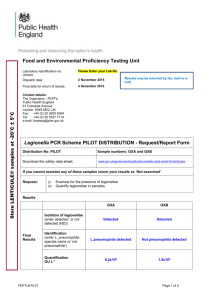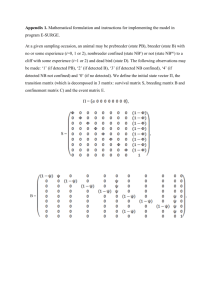A VISIBILITY TEST ON SPOT5 IMAGES
advertisement
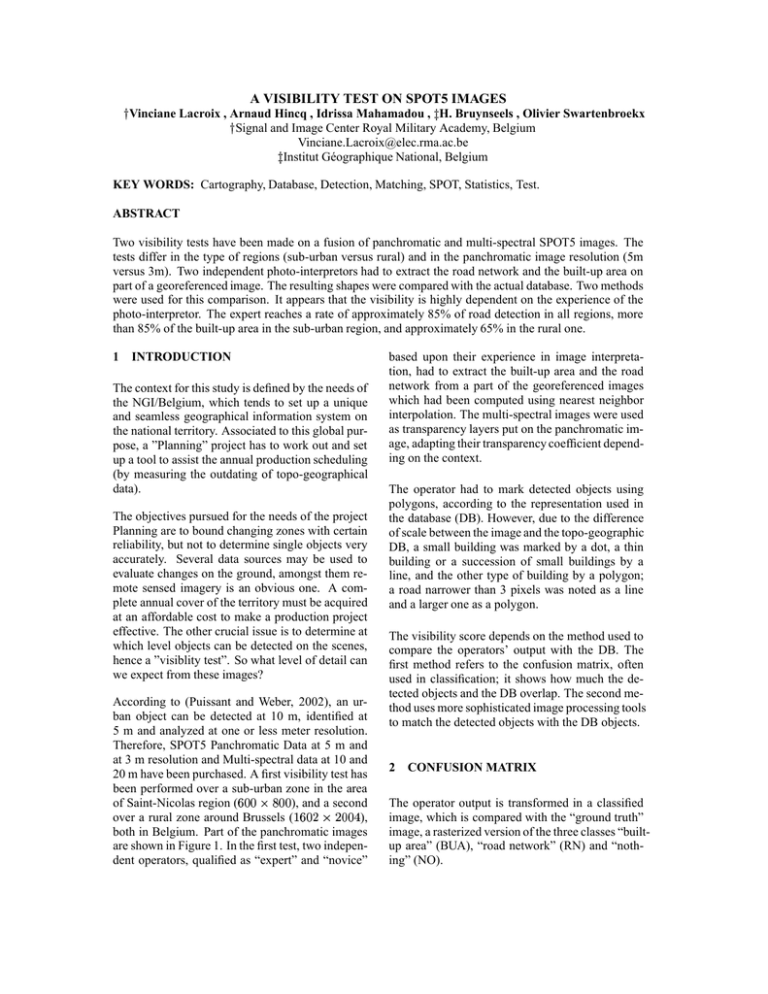
A VISIBILITY TEST ON SPOT5 IMAGES Vinciane Lacroix , Arnaud Hincq , Idrissa Mahamadou , H. Bruynseels , Olivier Swartenbroekx Signal and Image Center Royal Military Academy, Belgium Vinciane.Lacroix@elec.rma.ac.be Institut Géographique National, Belgium KEY WORDS: Cartography, Database, Detection, Matching, SPOT, Statistics, Test. ABSTRACT Two visibility tests have been made on a fusion of panchromatic and multi-spectral SPOT5 images. The tests differ in the type of regions (sub-urban versus rural) and in the panchromatic image resolution (5m versus 3m). Two independent photo-interpretors had to extract the road network and the built-up area on part of a georeferenced image. The resulting shapes were compared with the actual database. Two methods were used for this comparison. It appears that the visibility is highly dependent on the experience of the photo-interpretor. The expert reaches a rate of approximately 85% of road detection in all regions, more than 85% of the built-up area in the sub-urban region, and approximately 65% in the rural one. 1 INTRODUCTION The context for this study is defined by the needs of the NGI/Belgium, which tends to set up a unique and seamless geographical information system on the national territory. Associated to this global purpose, a ”Planning” project has to work out and set up a tool to assist the annual production scheduling (by measuring the outdating of topo-geographical data). The objectives pursued for the needs of the project Planning are to bound changing zones with certain reliability, but not to determine single objects very accurately. Several data sources may be used to evaluate changes on the ground, amongst them remote sensed imagery is an obvious one. A complete annual cover of the territory must be acquired at an affordable cost to make a production project effective. The other crucial issue is to determine at which level objects can be detected on the scenes, hence a ”visiblity test”. So what level of detail can we expect from these images? According to (Puissant and Weber, 2002), an urban object can be detected at 10 m, identified at 5 m and analyzed at one or less meter resolution. Therefore, SPOT5 Panchromatic Data at 5 m and at 3 m resolution and Multi-spectral data at 10 and 20 m have been purchased. A first visibility test has been performed over a sub-urban zone in the area of Saint-Nicolas region ( ), and a second over a rural zone around Brussels ( ), both in Belgium. Part of the panchromatic images are shown in Figure 1. In the first test, two independent operators, qualified as “expert” and “novice” based upon their experience in image interpretation, had to extract the built-up area and the road network from a part of the georeferenced images which had been computed using nearest neighbor interpolation. The multi-spectral images were used as transparency layers put on the panchromatic image, adapting their transparency coefficient depending on the context. The operator had to mark detected objects using polygons, according to the representation used in the database (DB). However, due to the difference of scale between the image and the topo-geographic DB, a small building was marked by a dot, a thin building or a succession of small buildings by a line, and the other type of building by a polygon; a road narrower than 3 pixels was noted as a line and a larger one as a polygon. The visibility score depends on the method used to compare the operators’ output with the DB. The first method refers to the confusion matrix, often used in classification; it shows how much the detected objects and the DB overlap. The second method uses more sophisticated image processing tools to match the detected objects with the DB objects. 2 CONFUSION MATRIX The operator output is transformed in a classified image, which is compared with the “ground truth” image, a rasterized version of the three classes “builtup area” (BUA), “road network” (RN) and “nothing” (NO). We use a slight variation of such a matrix, adding in each cell ' and ( where ' )! *# % and ( "! *#&% , the number of pixels normalized according to a row and to a column, respectively. When ! , ' and ( represents the user’s and producer’s index respectively. + 1,.-0/ -/ Table 1: A cell of our confusion matrix a. Part of a SPOT5 P image (5m) over Sint-Niklaas area (sub-urban) b. Part of a SPOT5 P image (3m) over Brussels area (rural) Figure 1: Test Images: view of the complete test zone and local zoom The confusion matrix of the first and second test are shown in table 2 a and b respectively. In each cell of the table 2 a the first and second line represents the normalized numbers generated by the expert and by the novice respectively. Only the expert worked on the second test zone. BUA RN NO Truth 2 Viewed 3 @< A=6> ? @EF> E G D;7 BUA 46587:9; BIJ HFEF>> B< J >B C 9D J >B 7:5 C 4 <KBL> ? 4F9:5 DC MD BIJ ?F> E BKE >< H @J A G 7M7 RN 283 I < F < > ? 8 ; 4 4 E J >B @K?IPBF> PB P?F> > ? < C N M:7 A> ;:7O4 C ;84 G 9 B >< EF> < J BL> E >= ?F> ? @EKABL> @? @ P >B P< PJ > PE NO 10786 D 7 L 4 ; M 9 JIELJ > =P J > CN C C P> P< @ >> ? 4G ; N9 EK@<L> A= ;D9 C ;:D C D < >= >? < > G NRQQ D8N S Global index: G ; S a. Test over Sint-Niklaas region (sub-urban) Ideally, the “ground truth” image size should be equal to the SPOT5 image. However, the scale of the DB is approximately 10 times finer so that objects of different nature projected at SPOT5 resolution may overlap. A raster 100 times larger than the SPOT5 image was thus necessary. On the other hand, the detected objects are also projected on the raster. Dots and lines are dilated, while polygons are filled up with pixels marked as BUA or RN. Traditionally, in a confusion matrix, the first row presents the ground truth classes ( ), while the first column represents the detected classes ( ). Usually each cell of such a matrix presents , the number of pixels detected as belonging to class while belonging to the ground truth class . The matrix interpretation is made easier by a normalization by the total number of pixels. For display purpose, a cell in our table contains "! $#&% . Truth 2 Viewed 3 BUA RN NO BUA C 4C C M 4FD:;; RN BJT@=L>> @ A 4C J ;:MM BFJ >> P JP PP <FBF>> 4 G:G N Q Global index: D ;S NO J P FH >> = EKJ BF= > < PJ BF> B EF> E 9:55 M;D 7:9DM <K?FHL> < > ? =IJ BLHL>> BB A A <PI@ >> J b. Test over Brussels region (rural) Table 2: Confusion matrix. BUA= Built-up area; RN= Road network; NO= Nothing. The false alarms are found in the last column of the table while the last row is made of the lacking elements. An ideal matrix would be diagonal. Several indexes of classification accuracy can be derived from such a matrix (Tso and Mather, 2001). To the producer’s accuracy and the user’s accuracy found in the diagonal, we have add the global index. A rough analysis of the matrix shows that: U There is a large amount of NO pixels in the DB. These pixels thus influence much the global index, generating an optimistic view. U Even though optimistic, this global index provides a rather poor classification rate. U In the sub-urban area, less then half of the DB built-up area and a little more than half of the DB road network is seen by the expert (see producer indexes). These values significantly drop in the rural area, as they both reach about 15%. U Proportionally, the road network is better detected than the built-up area. U There is a large amount of false alarms: around 30% in the sub-urban, up to more than 60% in the rural zone U The results are dramatically worse in the rural zone. The reason is that the image was not well geo-referenced, so that the detected objects often fall next to the DB elements. U The expert’s performance is approximately 15% better in both classes, while keeping a lower false alarm rate. A look at the confusion classes produced by the superposition of the detected objects onto the DB can give another view of the detection errors. In Figure 2, the detected elements that are superimposed to the correct DB elements are displayed in green, while the missing parts of the DB elements are in red, and the detected parts that are not in the DB (i.e. false alarms) are displayed in black. The left and right images show parts taken from the suburban and from rural area, respectively. This method, while giving some indications concerning the visibility, has several drawbacks, highlighted by Figures 2. U It does not make the difference between a whole object not detected and parts of non-detected objects. U It is highly sensitive to a slight displacement of the DB. U Dilated points and lines have fixed sized while small buildings have various sizes. U Dilation of points and lines provides some tolerance in positioning objects but might also introduce false error pixels. Because of these drawbacks, we have designed a matching method. 3 MATCHING METHOD In order to avoid the confusion matrix method drawbacks, a more sophisticated method has been implemented; the confusion matrix is pixel based, while the matching method is object-based. The DB is divided in the road network and the built-up area, then matching rules for each possible pair of detected elements and DB object are defined and tested. U Detected Buildings: – Points: point V point V small building, polygonal building – Lines: line V small buildings, line V polygonal building – Polygon: polygon V polygon V small buildings, polygonal building U Detected Roads: – Lines: line V linear road – Polygon: polygon V linear road 3.1 Road network Figure 2: Detail of superposing the DB onto image DB; Green= correct detection; Black= false alarm; Red= missing parts. Left: Rural area. Right: Suburban area. The roads in the DB are either represented by their circulation lanes or by their central axis, and by their contour. The latter are stored as polygons and the former as polylines. In the matching method, we use the polyline representation only. 3.2 Built-up area (ii) --> not matched (ii) --> matched (iii) Figure 3: Road network matching: line match ; First the road detected as lines are matched to line segments of the DB as illustrated in figure 3: (i) the detected road segments are projected, and the close DB line elements are found; (ii) if the line orientation match within +/- 10 degrees, and the distance between the segments is lower than 10m the segments are associated; (iii) if the projected segment covers only part of a DB segment and if the remaining DB segment is smaller than 10m, that remaining part is considered as detected as well; (iv) all detected segments without associated DB segment are considered as false alarms. Then, the road detected as polygons are considered as illustrated in figure 4: (i) the polygons are projected (in orange), dilated and filled (in blue); (ii) the remaining DB segments are projected on the latter and dilated; (iii) parts outside the dilated polygons are considered as not matched (in red) unless they are too small; (iii) remaining large uncovered polygon parts are considered as false alarms. Figure 4: Road network matching; left: detected polygons in orange, dilated and filled polygon in blue; right: polygonal match. Matched DB elements in green. False detected elements in red. The false alarms are thus made of non matched detected linear segments and parts of non-matched detected polygons. The missed elements are DB segments or part of DB segments that were not matched with a linear segment and did not fit in a detected polygons. As far as the Built-up area is concerned, small buildings are treated differently, and considered alone in the first phase: buildings detected as points or lines are first considered as potential match for small buildings. They are projected and the closest small buildings are found. In the case of more than one point lying close to a small building, only the closest will be considered as matched. In the case of lines, parts of the lines lying to far away from the small buildings are ignored if they are small, otherwise, they are kept in the set of non-matched detected elements. Figure 5 shows the results of matching points and lines on part of the DB: detected elements are displayed in blue, while matched and missed DB buildings are displayed in green, and red respectively. Figure 5: Matching BUA; in blue: detected buildings noted as points and lines; in green: matched DB buildings; in red: missed DB buildings Both the remaining elements of the DB and the detected polygons are projected. The DB polygons that are covered by more than 80 % of its surface by a detected polygon are considered as totally seen, otherwise, each of its connected parts is analyzed: if it represents less than 10 % of the total area, it is ignored, otherwise it is kept in the unmatched part of the DB. Similarly, the connected parts of the detected polygons lying outside the DB polygons are analyzed: if they represent more than 10 % of the total detected polygon, they are considered as false alarm, otherwise they are ignored. Finally, remaining polygons representing parts of the non-matched DB buildings might be considered as viewed if the that are narrower than a threshold, and if their width is indeed smaller than the original width of the building in the DB. The last process consists in trying to match the remaining points and lines with parts of polygonal DB elements. 3.3 Results 4 CONCLUSION Results of the matching method applied to both zones are shown in table 3 and table 4. The first column provides the percentage of detection, that is the proportion of well detected objects over the total size of these objects in the DB. The second column shows the percentage of false alarm, that is, the part of the detected objects for which no match could be found in the DB. Therefore, the addition of the first and second column does not necessarily sum to 100. In table 3, the upper number in a cell refers to the expert’s result, and the lower one, to the novice’s one. Good Detection False Alarms Built-up area 87.7 % 69.6% 14.09 % 18.5% Road Network 84.3% 68.4% 7.7% 12.5% Table 3: Results of the matching method in the Sub-urban area (5m) Good Detection False Alarms Built-up area 64.8% 31.2% Road Network 87.9% 5.5% Table 4: Results of the matching method in the rural area (3m) A visibility test of the road network and the built-up area has been made on SPOT5 image. Two methods have been proposed to estimate the portion of visible objects, and of false alarms. We showed that the confusion matrix method, often used in classification, is not suitable for getting such an estimate. We thus proposed an object oriented method, called the matching method, providing more realistic results, and a better view of what is missed, and what is misinterpreted. The object visibility is highly dependent on the experience of the operator and on the zone type. In the sub-urban area, approximately 85 % of the DB was seen by the expert operator while the novice makes 20 % less. In both tested zones, the Road Network was more visible than the Built-up area, with a larger difference in the rural area. The BUA visibility drops by about 20 % in the rural area, due to the large amount of small disseminated buildings missed by the operator. Despite results of both experiments cannot be compared due to their difference in landscape (i.e suburban versus rural), we may conclude that SPOT5 5m resolution data are sufficient to detect most of the Road Network in open area. As far as the builtup area is concerned, even the SPOT5 3m resolution seems insufficient to detect individual buildings. However, if only most of the building sets should be detected, the SPOT5 5m resolution data would be suitable enough. 5 ACKNOWLEDGMENT These results are much more optimistic than the results provided by the confusion matrix. More than 80% of the DB is seen by the expert in the sub-urban zone. In this zone, RN remains slightly more visible than BUA, while its visibility is about 13% better than BUA in rural zone. While looking at the BUA false alarms (or missed), a small part comes from too many small buildings identified (or missed) and a large part from parking that have been interpreted as buildings (or vice versa). The small buildings are more numerous in the rural zone, explaining the relatively low BUA detection rate. As far as the RN is concerned, much of the false alarms come from private roads or from interpretation errors. The missed roads are small secondary roads or roads in woody area. The team wish to thank Stephanie d’Hoop and Olivier Defays for having analyzed the satellite images. This study is part of the ETATS project, funded by the TELSAT program of the Scientific, Technical and Cultural Affairs of the Prime Minister’s Service (Belgian State). REFERENCES Puissant, A. and Weber, C., 2002. The utility of very high spatial resolution images to identify urban objects. Geocarto International 17(1), pp. 31– 41. Tso, B. and Mather, P., 2001. Classification Methods for Remote Sensed Data. Taylor & Francis, chapter Pattern Recognition principles, pp. 96–99.
